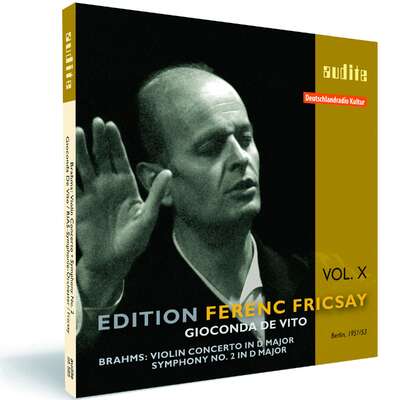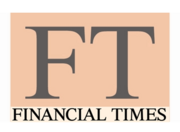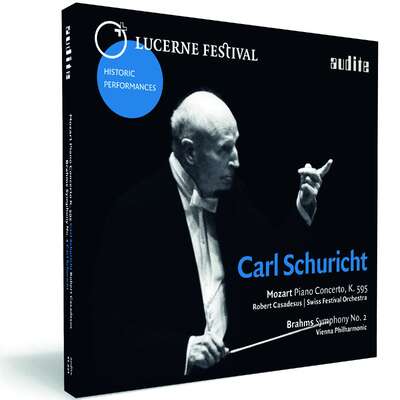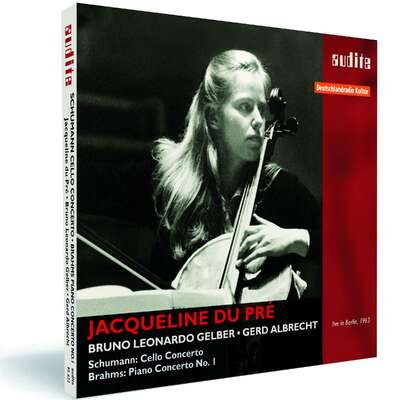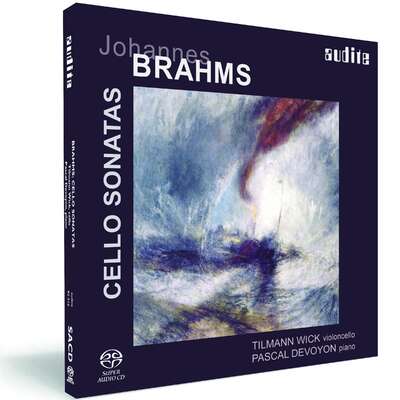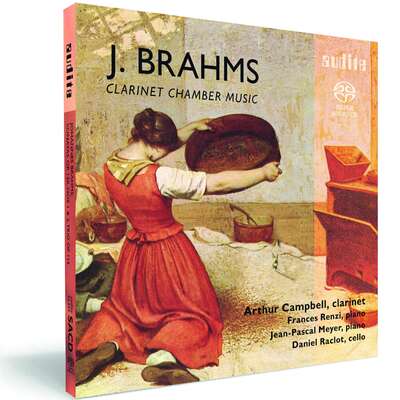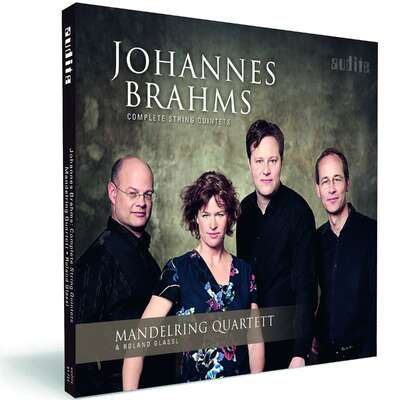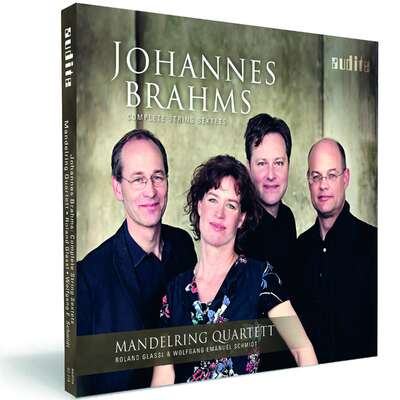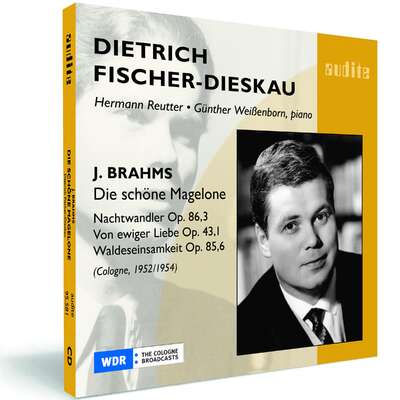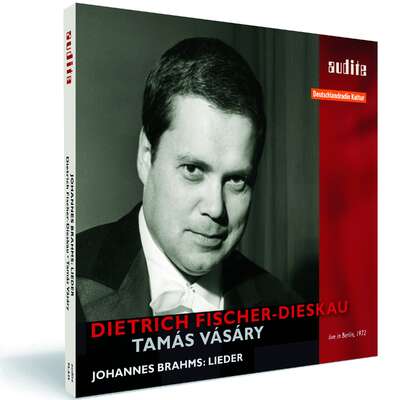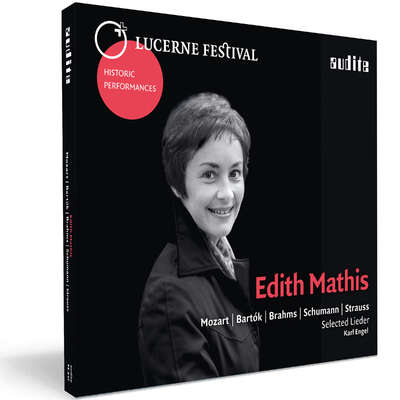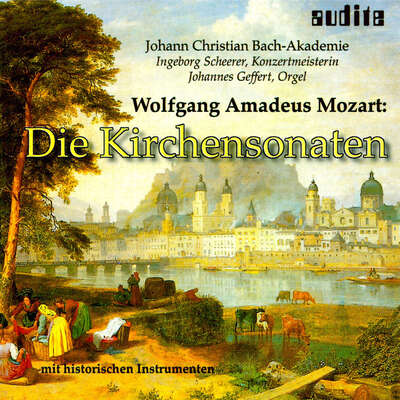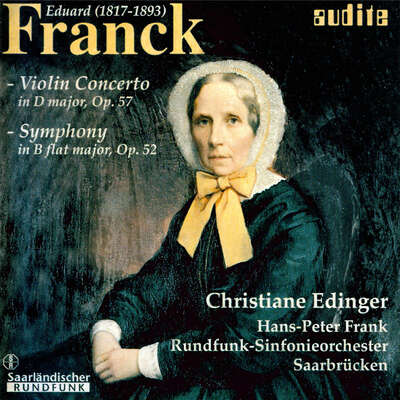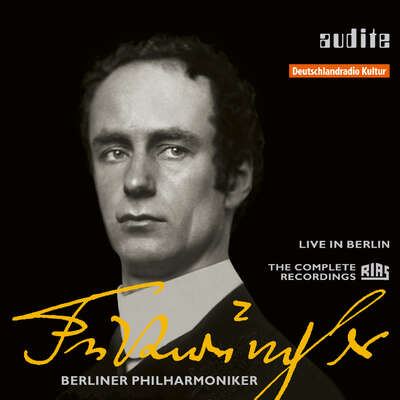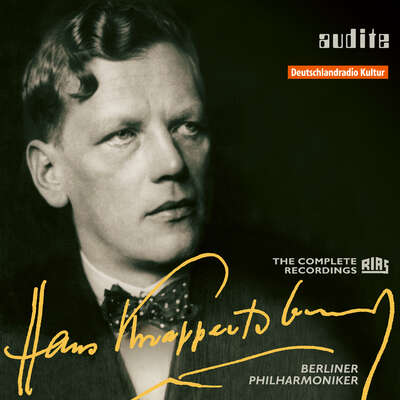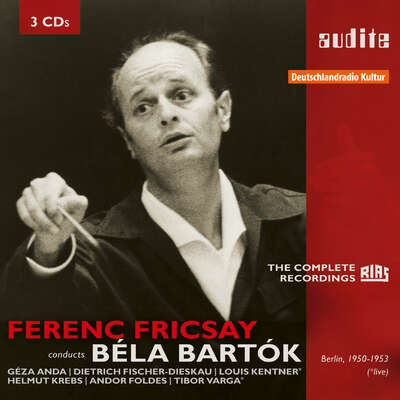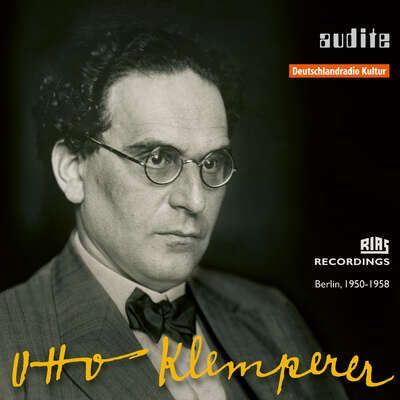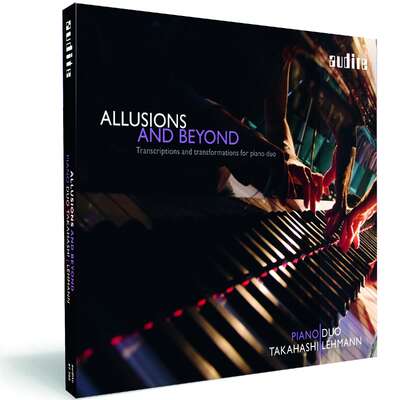
recording date: 1951 / 1953 “Her performance of the Brahms Violin Concerto in the early 1950s, under Ferenc Fricsay, was pervaded by a delicate lyricism and a romantic sorcery rarely encountered elsewhere.” Joachim Hartnack about Gioconda De Vito Gioconda De Vito , one of the great...more
"From the RIAS archives come two distinctly rare and exquisitely musical Brahms performances." (audaud.com)
Details
| Edition Ferenc Fricsay (X) – J. Brahms: Violin Concerto & Symphony No. 2 | |
| article number: | 95.585 |
|---|---|
| EAN barcode: | 4022143955852 |
| price group: | BCB |
| release date: | 1. January 2009 |
| total time: | 80 min. |
Bonus Material
Informationen
recording date: 1951 / 1953
“Her performance of the Brahms Violin Concerto in the early 1950s, under Ferenc Fricsay, was pervaded by a delicate lyricism and a romantic sorcery rarely encountered elsewhere.”
Joachim Hartnack about Gioconda De Vito
Gioconda De Vito, one of the great violinists of her time, was considered a Brahms specialist. The only evidence to date of her work with Ferenc Fricsay and the RIAS Orchestra is the above mentioned quote. Precisely this collaboration was captured in a superb monaural recording by the RIAS broadcasting company in Berlin – a stroke of luck, for De Vito had an aversion to the recording studio. Gioconda De Vito, Ferenc Fricsay and the RIAS-Symphonie-Orchester produce an exemplary realization of the concept of the “symphonic concerto”. A great deal of the cogency of this realization is owed to the precise dovetailing of soloist and orchestra, even in those passages in which De Vito grants herself a liberal use of rubato. With wonted translucence, Fricsay allows the solo instrumentalists in his orchestra to share the limelight with the violinist.
The recording reveals all of Gioconda De Vito’s strengths. She unfolds a large, singing tone, at once brilliantly radiant and warm. This accurate, crisply recorded performance by the RIAS-Symphonie-Orchester under Fricsay also brings out the very deliberate rhythmic organization with which she shaped her cantilenas.
Under Fricsay, the RIAS-Symphonie-Orchester also succeeds in turning their recording of Brahms’s Second Symphony into a touchstone of Brahmsian “orchestral chamber music.”
There is a “Producer’s Comment” from producer Ludger Böckenhoff about this production available.
The production is part of our series „Legendary Recordings“ and bears the quality feature „1st Master Release“. This term stands for the excellent quality of archival productions at audite. For all historical publications at audite are based, without exception, on the original tapes from broadcasting archives. In general these are the original analogue tapes, which attain an astonishingly high quality, even measured by today‘s standards, with their tape speed of up to 76 cm/sec. The remastering – professionally competent and sensitively applied – also uncovers previously hidden details of the interpretations. Thus, a sound of superior quality results. CD publications based on private recordings from broadcasts cannot be compared with these.
Reviews
Die Tonkunst | Juli 2013 | Tobias Pfleger | July 1, 2013 Edition Ferenc Fricsay – Werke von Haydn, Mozart, Beethoven, Rossini, Bizet, Brahms, Strauß, Verdi, Bartók u. a.
Ferenc Fricsay gehörte zu den bedeutenden Dirigenten des mittleren 20.Mehr lesen
Classic Collection | TUESDAY, DECEMBER 7, 2010 | December 7, 2010
The recording reveals all of Gioconda De Vito's strengths. She unfolds a large, singing tone, at once brilliantly radiant and warm. This accurate, crisply recorded performance by the RIAS-Symphonie-Orchester under Fricsay also brings out the very deliberate rhythmic organization with which she shaped her cantilenas. Mehr lesen
Gramophone | February 2010 | Rob Cowan | February 1, 2010
With golden strings attached
Fritz Kreisler's radiant playing – and a handful of Brahms Violin Concertos
It is surely no exaggeration to claim that, aside from the human voice, the violin, as recorded, offers the most vivid indicator of how performingMehr lesen
In 1904 the youthful Kreisler was already very much the gentleman of virtuosos and his playing as captured here is both witty and radiant, aided significantly by Ward Marston's superb transfers. Another Naxos arrival features the Italian violinist Giaconda De Vito whose 1941 Berlin recording of the Brahms Concerto under Paul van Kempen displays a keen temperament with plenty of controlled flexibility in the phrasing. The equally well transferred coupling (Mark Obert-Thom was at the desk here) is Mozart's Third Violin Concerto recorded in London in 1949 with the Royal Philharmonic under Sir Thomas Beecham, another performance notable for its strong personality though the most memorable moments come at the tranquil close of the slow movement where De Vito's quiet restatement of the opening theme has to be heard to be believed. An alternative De Vito account of the Brahms, again recorded in Berlin but in the early Fifties under Ferenc Fricsay, features superior sound and a broader take on the first movement, while the coupling is a lean, energetic and often poised account of Brahms's Second Symphony, again under Fricsay, both recordings taken from German Radio. A third recent historic Brahms Violin Concerto (1950) couldn't be more different. The violinist is Nathan Milstein whose fiery playing fits the white-hot context of Victor de Sabata's conducting. The New York Phil is pushed to its very limits: I wouldn't call it exactly the subtlest account around, nor the best recorded (an understatement, sadly), but as for visceral excitement, few other vintage versions match up. The coupling is a somewhat more reposeful Mendelssohn Concerto under Igor Markevitch (Lucerne, 1953).
Andromeda have put together a number of recordings by Furtwängler's one-time concertmaster at the Berlin Philharmonic, Gerhard Taschner, principally concertos by Hindemith (Kammermusik No 4), Khachaturian, Fortner, Bruch (No 1), Mendelssohn and Pfitzner, and various chamber works by Schubert (Trio No 1 with Hoelscher and Gieseking, Sonatina, D384), Brahms (Trio No 1 with Hoelscher and Gieseking again), and so on. Some of the finest playing is in solo Bach, especially the great D minor Chaconne from 1943. I'd call Taschner distinguished rather than "great" in the sense that, say, David Oistrakh's playing was great. Indeed the palm recordings – especially in the finale of Schubert's Second Piano Trio (both Trios are included) where the disturbing restatement of the second movement's principle theme is like a powerful but troubling memory. And I doubt that there's a more voluptuous account in existence of Brahms's great Trio in B major (Op 8), the Oistrakh ensemble more than ever suggesting premonitions of the great Double Concerto. Both Mendelssohn Trios are included (the D minor is especially memorable) and Czech music is represented by lovingly cultivated performances of three Romantic masterpieces, Dvorak's F minor and Dumky Trios and the Smetana G minor. Repeats are plentiful and time and again one realizes anew what a gem the trio had in pianist Lev Oborin, in Schumann's D minor for example, and the Russian repertoire in particular which has rarely sounded so grandly communicative. Issues of recording quality notwithstanding – and none of the tapes fall too far below par, nor Brilliant's transfers – these versions of Tchaikovsky's Trio, Rachmaninov's Trio elegiaque, Glinka's Trio pathetique, Taneyev's Op 22 (a masterpiece still too little known) and Rimsky-Korsakov's C minor Trio (completed by Maximilian Steinberg) are uniquely idiomatic. As to classical fare, there are two Haydn trios included (Nos 43 and 44), two by Beethoven (the Ghost and Op 1 No 3) as well as a fine Triple Concerto under Alexander Orlov and, additionally, trios by Chopin, Ravel and Shebalin.
As so often with these collections, Ateş Orga provides excellent notes. Thinking of possible future Brilliant boxes, the conductor Nikolai Golovanov has to be a priority (a Rozhdestvensky collection is, I understand, imminent), and what about singers, people like Andrei Ivanov or Zara Dolukhanova? Still, one mustn't be greedy. This is a fabulous collection.
Fanfare | Issue 33:2 (Nov/Dec 2009) | Jerry Dubins | November 1, 2009
In a ranking of the 20th century’s great violinists, Gioconda de Vito (1907–1994) would probably not be among the top 10, possibly not even amongMehr lesen
De Vito never aspired to be a great international star. She was born in a small southern Italian town to a wine-making family, and for much of her life preferred home to the touring circuit. Her break came in 1948, when she made her London debut under Victor de Sabata playing the Brahms Concerto, which led to appearances with Menuhin and Stern at the Edinburgh Festival and to a number of concerts under Furtwängler. Though invited to the U.S. by Toscanini and Charles Munch, she declined. The Brahms Concerto became a de Vito specialty and her signature piece. Reportedly, she studied it for 11 years before playing it in public, and then proceeded to record it numerous times. Her first go at it on a recording was a live performance in 1941 on 78s with Paul van Kempen and the Berlin State Opera Orchestra. In another live performance from 1952, she recorded the Concerto with Furtwängler and the Turin Radio Orchestra, and again a year later with Rudolf Schwarz and London’s Philharmonia. All of these recordings can be had on CD, or, if you prefer, you can shell out ridiculous sums of money to purchase them on LPs that are still circulating on Internet auction and collector sites.
De Vito’s Brahms may not make a believer out of an atheist as, rumor had it, her Mendelssohn did of one listener, but this studio recording from 1951 under Ferenc Fricsay leading the RIAS Symphony Orchestra—better known today as the Deutsches Symphonie-Orchester Berlin—may afford us perhaps the best portrait there is on record of the violinist’s vision of this work. I say this because the recording itself is exceptionally good, with balanced, detailed sound, excellent dynamic range, and a luminescent halo that seems to surround the soloist. De Vito draws from her instrument a pure and extremely sweet tone, and her playing remains unforced and unperturbed even in the Concerto’s most technically taxing passages. Not even a heart of stone could fail to be moved by her performance or fail to acknowledge her artistry.
That said, I am not prepared to accord this top honors among Brahms Violin Concerto recordings, and here is why. Fricsay and de Vito are not of similar minds and hearts as to how this score should go. He wants to press forward; she wants to hold back. He runs a tight ship, steering a straight and steady course; she takes shore leave to sightsee at every port. His is a classically structured reading; hers is as romanticized as they come. Fricsay, of course, is too much the professional to allow the performance to become a catfight or a contest of wills. He accommodates de Vito at every turn, but one hears in the tutti passages where Fricsay would take things if he didn’t have to defer to his soloist. Though I haven’t heard the violinist’s recording with Furtwängler, my suspicion is that he was probably a better fit for her temperamentally than was the more business-like, more closely adherent to the score Fricsay. Clearly, de Vito’s many warmly received appearances with Furtwängler speak to a more closely shared musical bond.
Nothing could reinforce this observation more than Fricsay’s reading of Brahms’s D-Major Symphony on this disc. Also a studio recording, dating from 1953, this is one of the more forward-pressing performances I’ve heard. There is no rubbernecking to ogle the roadside scenery, not even the slight slowdown that many conductors take at the appearance of the first movement’s second theme. But, while Fricsay may be highly disciplined, he’s not matter-of-fact. One does not sense for a single moment that this is a routine run-through or that either conductor or orchestra is disengaged. Not surprising for a recording of this vintage, the first movement exposition repeat is bypassed, but in every other way, this is as modern a performance of Brahms’s Second Symphony as you are likely to hear. And if the recorded sound on the Concerto was exceptionally good, the recorded sound in the Symphony is nothing short of fantastic.
In past reviews, I’ve held up Bruno Walter’s mono studio recordings of the Brahms symphonies with the New York Philharmonic as a benchmark. Walter’s Second was recorded the same year, 1953, as Fricsay’s. Walter, who is by no means a slowpoke, delivers the score in 38:36. Fricsay, at 37:47, is faster still by almost a minute. But beyond tempo variances, if I had to describe a difference in interpretive approach, it would be to say that Fricsay is Walter, but without the Gemütlichkeit.
Whatever place Gioconda de Vito occupies in the history of violin playing, hers was a unique voice, and I can’t imagine it being heard in better form or captured in better sound than it is here. Fricsay was also one of the 20th century’s great podium masters, and it should be incumbent on every serious collector to hear him at the top of his game. Audite is to be commended for the superb job they’ve done in remastering and transferring this material. This release gets my strongest recommendation.
International Record Review | October 2009 | October 1, 2009
Igor Markevitch was at the height of his powers in the early 1950s and two discs of broadcast recording' with the RIAS SO, Berlin, have appeared onMehr lesen
The second disc is more interesting. It opens with the Suite No. 2 from Daphnis et Chloé by Ravel. This is very fine indeed, with Markevitch at his most engaged and expressive, and it's good to have the chorus parts included too. Stravinsky's Le Sacre du printemps was always one of this conductor's great specialities (he made two EMl studio recordings of the work in the 1950s alone) and here we have a live 1952 version that is staggeringly exciting and very well played. Few other conductors could deliver such thrilling versions of the Rite in the 1950s, but Ferenc Fricsay was assuredly one of them, and this was, after all, his orchestra (their own stunning DG recording was made two years after this concert). After this volcanic eruption of a Rite, the final item on the disc breathes cooler air: the Symphony No. 5 (Di tre re) by Honegger. Warmly recommended, especially for the Stravinsky (Audite 95.605, 1 hour 13 minutes).
Michael Rabin's too-short career is largely documented through a spectacular series of studio recordings made for EMI, but these never included the Bruch G minor Concerto. Audite has issued a fine 1969 live performance accompanied by the RIAS SO, conducted by Thomas Schippers, transferred from original tapes in the archives of German Radio. Rabin's virtuosity was something to marvel at but so, too, was his musicianship. His Bruch is thoughtful, broad , rich-toned and intensely satisfying. The rest of the disc is taken up with shorter pieces for violin and piano. The stunning playing of William Kroll's Banjo and Fiddle is a particular delight, while other pieces include Sarasate's Carmen Fantasy and Saint-Saëns's Havanaise. Fun as these are, it's the Bruch that makes this so worthwhile (Audite 95.607, 1 hour 10 minutes).
There have been at least three recordings of the Brahms Violin Concerto with Gioconda De Vito (1941 under Paul van Kempen, 1952 under Furtwängler and a 1953 studio version under Rudolf Schwarz), but now Audite has unearthed one with the RIAS Symphony Orchestra, conducted by Fricsay. Recorded in the Jesus-Christus-Kirche on October 8th, 1951, this is a radiant performance. De Vito's rich sound is well caught by the RIAS engineers and the reading as a whole is a wonderful mixture of expressive flexibility within phrases and a strong sense of the work's larger architecture. In this very fine account she is much helped by her conductor: Fricsay is purposeful but fluid, as well as propulsive in both the concerto and the coupling: Brahms's Second Symphony, recorded a couple of years later on October 13th, 1953. This is just as impressive: an imaginatively characterized reading that is affectionately shaped in gentler moments (most beautifully so at the end of the third movement) and fiercely dramatic in the finale. The mono sound, from the original RIAS tapes, is very good for its age. A precious disc celebrating two great artists (Audite 95.585, 1 hour 20 minutes).
Friedrich Gulda's playing from the 1950s is documented through a series of Decca commercial recordings and some fine radio recordings, including a series made in Vienna on an Andante set (AN2110, deleted but still available from major online sellers). I welcomed this very warmly in a round-up when it appeared in 2005, and now Audite has released an equally interesting anthology of Gulda's Berlin Radio recordings. Yet again, here is ample evidence of the very great pianist Gulda was at his best. There is only occasional duplication of repertoire, such as the 1953 Berlin Gaspard de la nuit by Ravel, and Debussy's Pour le piano and Suite bergamasque, immensely refined and yet strongly driven in these Audite Berlin recordings, though 'Ondine' shimmers even more ravishingly in the 1957 Vienna performance (but that's one of the greatest Gaspards I've ever encountered). The opening Toccata from Pour le piano has real urgency and tremendous élan in both versions. The Chopin (from 1959) includes what I believe is the only recording of the Barcarolle from this period in Gulda's career (two versions exist from the end of his career) – it grows with tremendous nobility and Gulda's sound is marvellous, as is his rhythmic control – it’s never overly strict but the music's architecture is always apparent. This follows the 24 Préludes. Gulda's 1953 studio recording has been reissued by Pristine, and this 1959 broadcast version offers an absorbing alternative: a deeply serious performance that captures the individual character of each piece with imagination and sensitivity.
The Seventh Sonata of Prokofiev was taped in January 1950, just over a year after Gulda had made his studio recording of the same work for Decca (reissued on 'Friedrich Gulda: The First Recordings', German Decca 476 3045). The Berlin Radio discs include some substantial Beethoven: a 1950 recording of the Sonata, Op. 101 and 1959 versions of Op. 14 No. 2, Op. 109, the Eroica Variations. Op. 39 and the 32 Variations in C minor, WoO80. Gulda's Beethoven has the same qualities of rhythmic control (and the superb ear for colour and line) that we find in his playing of French music or Chopin, and the result is to give the illusion of the music almost speaking for itself. The last movement of Op. 109 is unforgettable here: superbly song-like, with each chord weighted to perfection. Finally, this set includes Mozart's C minor Piano Concerto, K491, with the RIAS SO and Markevitch from 1953 – impeccably stylish. This outstanding set is very well documented and attractively presented (Audite 21.404, four discs, 4 hours 5 minutes).
American Record Guide | September/October 2009 | Radcliff | September 1, 2009
Ferenc Fricsay gives down-the-middle interpretations of the Brahms in the best mannerless mid-century manner, yet the concluding bars of the symphonyMehr lesen
Kulimu | 35. Jg. Heft 1 | Thomas Schulz | July 1, 2009 Erinnerung an eine große Geigerin des 20. Jahrhunderts
Die 1907 in Apulien geborene und 1994 in Rom verstorbene Gioconda de VitoMehr lesen
Financial Times | July 2009 | July 1, 2009
The Hungarian conductor Ferenc Fricsay, who died in 1963 aged 48, was oneMehr lesen
Scherzo | mayo 2009 | Enrique Pérez Adrián | May 1, 2009 Fricsay,Karajan
Sigue la extraordinaria Edición Frícsay en el sello alemán AuditeMehr lesen
www.classicstodayfrance.com | Mai 2009 | Christophe Huss | May 1, 2009
"Intéressante" parution dans la série Fricsay, qui apporte quelque choseMehr lesen
Diverdi Magazin | 181/mayo 2009 | Roberto Andrade | May 1, 2009
El Brahms más optimista
Nueva entrega de la serie Fricsay de Audite
No es frecuente que en un CD aparezcan reunidas dos obras de Brahms optimistas que, por una vez, nos alejan del ambiente dramático, sombrío oMehr lesen
La razón de ser de esta publicación de Audite, décimo volumen de la serie que viene dedicando a Ferenc Fricsay (1914-1963), es la presencia del gran maestro húngaro, a cuya discografia añade una obra hasta ahora ausente de ella, el Concierto para violín de Brahms. El estupendo trabajo de Fricsay en esta partitura realza la labor de la violinista italiana Gioconda de Vito, que desarrolló la parte más brillante de su carrera en los años 50. Artista correcta y musical, no luce en esta obra, tan difícil para el solista, la excelencia tímbrica o técnica ni la creatividad que permitieran compararla con los grandes que la han grabado, cuya muy amplia lista encabezan Oistraj y Heifetz.
Lo más destacado del CD es la Segunda Sinfonía de Brahms, admirablemente construida por Fricsay sobre la base de un planteamiento clásico por tempi, por el equilibrio de planos y sonoridades y por un fraseo muy intencionado, que se beneficia de una muy buena realización orquestal – Fricsay era tan paciente como exigente en los ensayos – bajo la guía de una batuta realmente inspirada. Y si al final de la obra se permite cierta libertad en los tempi, con algún que otro accellerando más que justificado por el impetuoso desarrollo de la música, ello le sirve para rematar con brillantez esta muy bella versión de buen sonido monoaural.
Ojalá el sello alemán pueda sorprendernos con algún registro de las Sinfonías Primera, Tercera y Cuarta de Brahms, ausentes hasta la fecha en la discografia del maestro.
andante | April 2009 | April 1, 2009
Rezension siehe PDFMehr lesen
La Musica | April 2009 | April 1, 2009 Ferenc Fricsay Editions
Rezension siehe PDFMehr lesen
www.codaclassic.com | April 2009 | April 1, 2009
Rezension siehe PDFMehr lesen
Audiophile Audition | February 2009 | Gary Lemco | February 14, 2009
From the archives of RIAS, Berlin come two distinctly rare and exquisitelyMehr lesen

